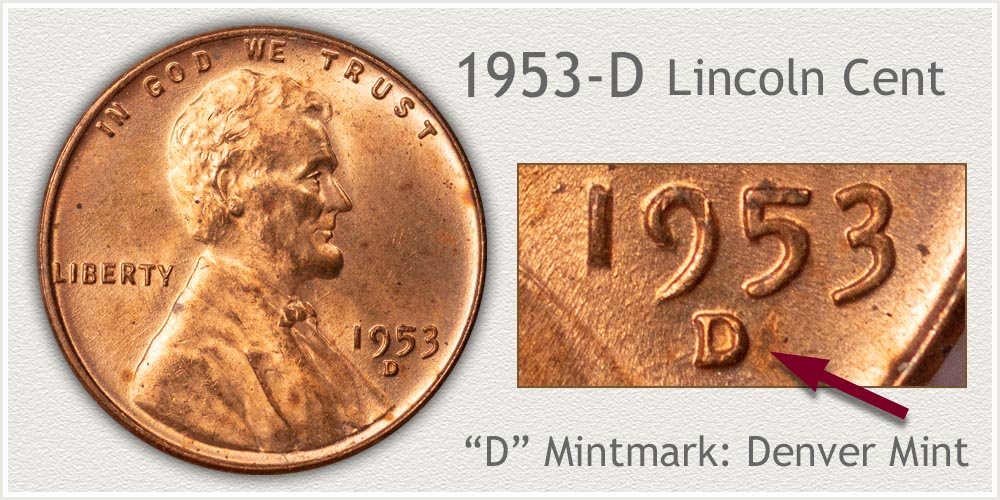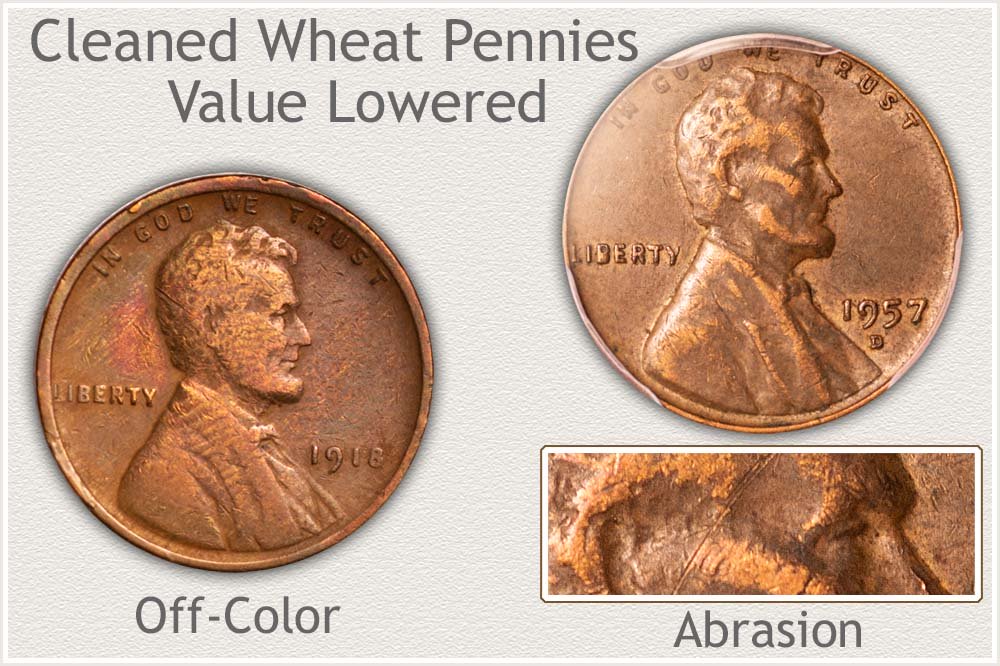Coin Values Moving with Precious Metals: Up-Dated 12/8/2025: Gold $4212 | Silver $58.12
1953 Penny Value
1953 penny value is dependent on judging condition. Collectors assemble sets paying close attention to "Grade" of individual coins. Visual differences in condition are recognizable. In the market values tend to adjust matching demand and scarcity.
Viewing the value chart highlights a premium begins with the Extremely Fine grade. Comparing your coin to grading images narrows its condition range.
Confirming Date and Mint Mark is a first step to reading the chart and determining variety of your coin. Follow with judging grade.

Steps Leading to Value:
- Step 1: Date and Mintmark Variety – Identify each date and its mintmark variety.
- Step 2: Grading Condition – Judge condition to determine grade. A standard to each grade is used to judge condition.
- Step 3: Special Qualities – Certain elements either enhance or detract from value.
| 1953 Lincoln Penny Value | ||||
|---|---|---|---|---|
| Condition of Coin | ||||
| Date | Good | Fine | Extremely Fine | Uncirculated |
| 1953 Lincoln Penny Value Up-Dated | 2025 | |||
| 1953 | $0.02 | $0.02 | $0.03 | $1.18 |
| 1953 D | $0.02 | $0.02 | $0.03 | $0.84 |
| 1953 S | $0.02 | $0.03 | $0.04 | $1.72 |
Reading the chart and deciding where your coin fits is part of a value process. Key factors are needed. Date | Mint Mark | Condition
Date and mint mark combinations identify the correct variety 1953 penny. Three mints struck wheat pennies in 1953. San Francisco stands out as a popular variety. Images locate the mint marks of the branch mints.
Judging condition begins with first impressions. Is the coin flat and tired in appearance, verses nice and well detailed? Bold features of Lincoln with crisp lettering indicates an above average condition coin.
Images comparing different stages of wear are used in the grading section to match your coin. Attention to subtle points of condition are described.
Step 1: | Date and Mintmark Combination
1953 Penny Varieties
Now becoming an older coin, a wheat penny is part of an enjoyable series to collectors. Ample supplies of the second era (1934 to 1958) coins provides an affordable collecting experience. Of the three varieties struck in 1953; San Francisco issues capture the greatest interest and a small premium.
1953 Lincoln Penny
No Mintmark Under Date: Philadelphia Mint Struck the Coin

Philadelphia contributed 256,883,800 1953 pennies to the year's production. Totaling over a billion coins when all 1953 varieties are combined. On the rarity scale, considered: Abundant
Needed as part of date and mint collections, a 1953 penny enjoys demand from both advanced and beginner collectors. Each are looking for different qualities. Higher end sets seek Mint State grade coins, young and new collectors search for lightly circulated examples. Inspect Lincoln's hair and ear, a clear separation indicates an above average piece.
1953-D Lincoln Penny
"D" Mintmark Under Date: Denver Mint Struck the Coin

Denver mint contributed the highest number of 1953 pennies, striking 700,515,000 coins. 9th highest mintage of all date and mintmark combinations for the entire series. Ample supplies contribute to its Abundant rating on the rarity scale.
Lightly circulated to full Mint State (like new) condition examples are preferred by collectors. An advanced set of wheat pennies features a 1953-D penny still retaining bright lister. A circulated set aspires to include a slightly worn example, bold details on both sides, and traces of wear.
1953-S Lincoln Penny
"S" Mintmark Under Date: San Francisco Mint Struck the Coin

San Francisco wheat pennies, denoted as 1953-S are Abundant on the rarity scale. Although the least amount struck of the three varieties, it is still available today in a wide range of grades. Stand out qualities are needed to achieve a premium value.
Toing to an old wheat penny is a normal occurrence. Copper is prone to turn from a bright red to shades of brown, storage and handling contribute to fading into a brown coloration. In the market a premium is placed on coins closest to original bright shades of red than deeper shades of brown.
Step 2: | Judge Condition to Identify Grade
1953 Penny Value Tied to Condition
Condition is the level of preservation the coin displays. A grade denotes this and is used by collectors when describing and placing a value on a coin. Images below help visualize these different stages of condition.
Grading this 1953 cent involves close inspection of small areas; a magnifying glass is useful. If a magnifying glass is not available, an image is often taken and used to enlarge key points.

Uncirculated Grade: An uncirculated - mint state 1953 cent shows no signs of wear to any surface of design, legends, and fields. Mint frost, the luster of a coin imparted at the time of striking remains undisturbed.
High in profile is an area starting at Lincoln's jaw and extends to his chin. Luster composed of a fine texture covers this area on a mint state coin. Smoothness of the jaw when compared with close by areas indicates wear. Tilt the coin under a light and look close for a consistent surface confirming the mint state grade.
Even bright color is displayed by this penny. Original luster reflects from the high areas and lower fields. Any wear to these surfaces would dull the shine and smooth the delicate texture of the metal.

Judge Color and Wear of 1953 Penny: Color of a freshly minted wheat penny - a bright red-gold - changes over time depending on the level of protection from air. Shades of brown develop and lays on top of the surface, toning copper. This toning is not used as an indication of wear. Actual wear - removal of metal is the deciding factor between a circulated grade and uncirculated grade.
All three coins imaged are examples of mint state coins without any wear to the surface. The visual difference is the amount of toning displayed. Lincoln's jaw at the chin is without any wear on all examples.
Values, in general terms, follow the progression from bright to deeply toned. A 1953 penny still bright with luster is a premium quality coin and sought by many collectors. The moderately toned 1953 is still visually appealing to many collectors. A wheat cent toned over most of the surface is technically within the mint state grade, however in the least demand.

Extremely Fine Grade: A small amount of metal has worn away on high points of an Extremely Fine grade wheat penny. Only slight wear is the important judgement to recognize to obtain the grade. Once major details begin to fade and smaller details are completely missing, a lower grade is needed to describe condition.
An area helpful to judging condition, is Lincoln's jaw extending to his chin. Small flat areas are beginning to show on the high points. These flat spots are very minor leaving the contour of the jaw intact. Additionally, his cheek showing only traces of smoothing is a good indication of extremely fine condition.
Appeal of the example penny is the strong; a well-defined portrait, legends, and a clear date. Light brown toning contrasted with deeper shades highlight these major features.

Average Circulated Condition: Today, wheat pennies worn to less than extremely fine grade are available in quantities. Those minted in the 1950's are the bulk of these available coins.
An average circulated coin displays wear flattening many once bold features of Lincoln. His jaw and cheek are noticeably flattened. Often facial features are merged and no longer separated. Waves of hair with merging flat areas confirms heavy circulation wear.
These moderate to heavy wear coins are the base value examples. At this stage of condition, eye appeal becomes very important. Any noticeable distractions; dark colors, heavy marks, and excessive wear eliminates the coin from collector acceptance.
Video | Grading Lincoln Wheat Pennies
To further illustrate grading and pinpoint areas to consider Grading Lincoln Wheat Pennies. adds video, images, and descriptions to identify subtle details to condition. Many date and mintmark varieties of wheat pennies have large value ranges because of condition.
Step 3: | Special Qualities Enhancing Value
Identify Lower Value Cleaned Wheat Pennies
A cleaned wheat penny places it in a separate value category. Cleaning a copper coin lowers its appeal to a dealer and collector. Dealers perform a function of providing a market place, their reputation is important to offer quality at a competitive price. Collectors ultimately pass or reject any coin considered to enter a set they a building.
Both dealers and collectors develop skills at detecting the changes made to a coin by cleaning. Unnatural colors are recognized, subtle signs to the surface, and overall look are judged. Preferences today are natural, original surfaces, as a starting point and then condition is judged.

This 1918 wheat penny was cleaned in the past. Indications are the colors that have developed, unnatural to a circulated coin. An old copper coin with wear is expected to have a shade of brown toning. Examples are quickly recognized as off color.
Second example was cleaned using a heavy touch, likely attempting to remove debris. Any method using a cloth or brush removes natural toning from the high points and leaving brightened metal exposed.
In both of the examples no improvement was made in appearance, condition and importantly, value. Resulting in both coins passed by dealers and collectors.
One of the safest ways to maintain current and future value is never clean a coin.
ReferencesUS Mint. 1954 US Mint Annual Report https://nnp.wustl.edu/library/publisherdetail/51
Coin Values | CoinStudy Articles
Lincoln Wheat cents span the years 1909 through 1958. From the top condition coins collected by advanced collectors to worn examples; to an affordable collection for young collectors, the range of value is extensive. Identify your date, mint and condition and refer to the value chart.
How to Reap the Best Value When Selling Wheat Pennies
As with all selling processes; organizing the coins in a manner a dealer can efficiently asses their worth aids in returns to you. Selling a few or many wheat pennies for the best value starts by separating the coins into "market categories" for consideration by the dealer.
★ Coin Values Discovery finds 1953 Penny Value and...
All US coin values. Recognize your old coins using the image links leading to value charts. Date | Mintmark | Condition are considered; all described and imaged within each series. Surprising value is often found in the smallest of detail.